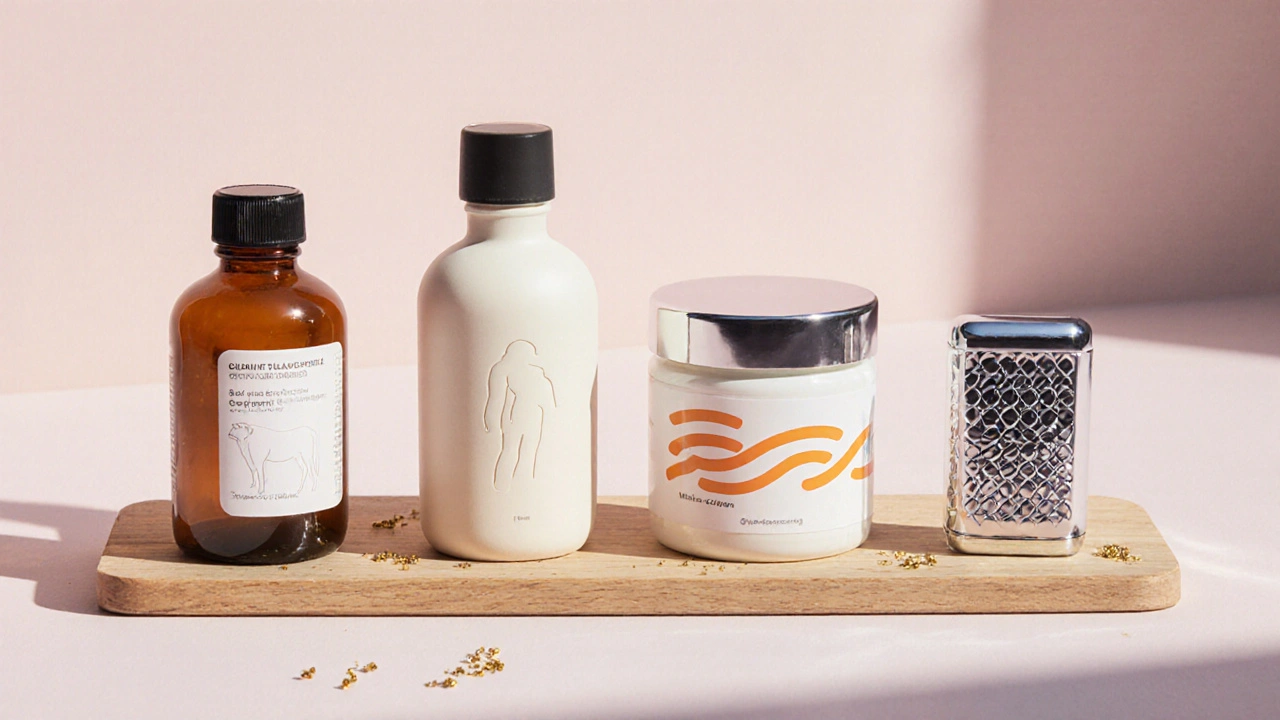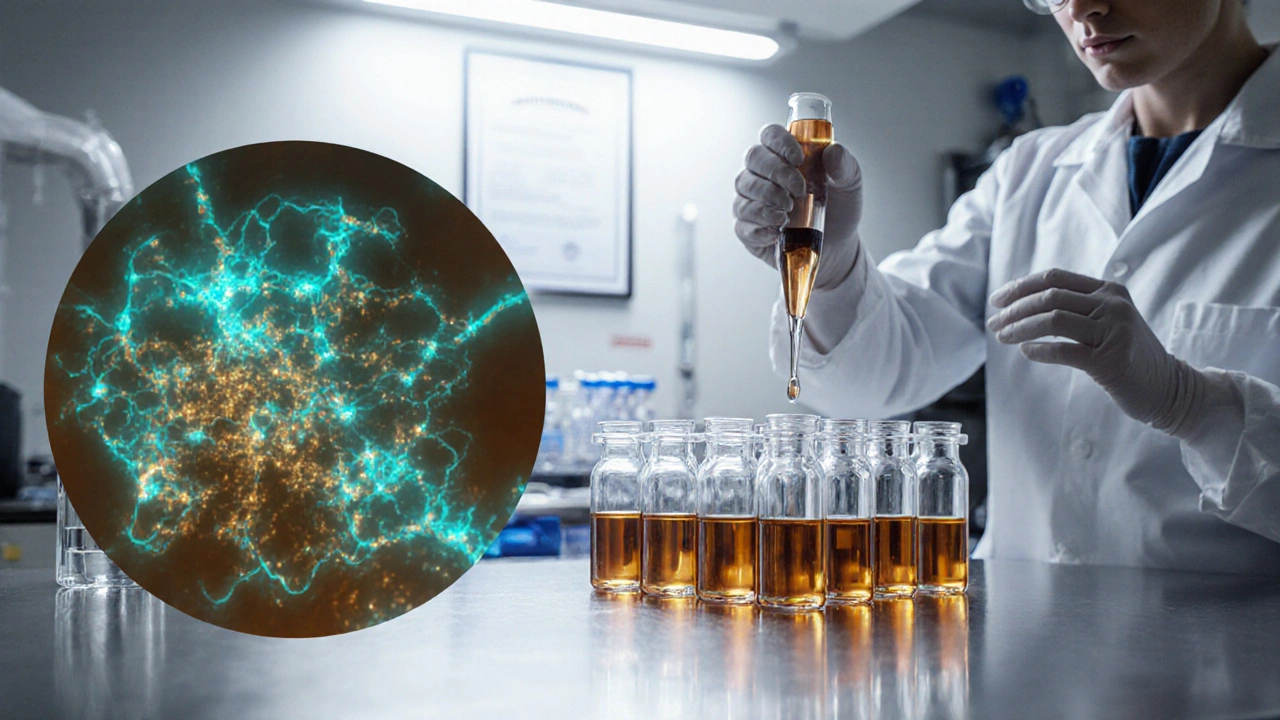Placentrex vs Alternatives Comparison Tool
Use this tool to compare Placentrex with alternative placental supplements based on five key factors:
- Source authenticity: Human, bovine, or synthetic
- Nitrogen content: Indicates amino acid density
- Active compound profile: Growth factors and hormones present
- Dosage clarity: Clear labeling of serving sizes
- Regulatory compliance: SAHPRA or equivalent registration
Placentrex
Source: Human placental tissue
Nitrogen Content: ~22%
Active Compounds: IGF-1, PlGF, estradiol trace
Dosage: 1–2 ml liquid or 0.5 g powder/day
Price: $60–$80/month
Regulatory Status: Registered as a medical food
Alternatives
- Placenta Pro: Bovine placenta, ~14% nitrogen
- Placenta Max: Human + marine collagen, ~20% nitrogen
- Dermalogen Plus: Synthetic peptides, 0% nitrogen
- Collagen Peptide Complex: Bovine collagen only
| Feature | Placentrex | Placenta Pro | Placenta Max | Dermalogen Plus |
|---|---|---|---|---|
| Source | Human placental tissue | Bovine placenta | Human placenta + marine collagen | Synthetic peptides |
| Nitrogen Content | ~22% | ~14% | ~20% (human part) | 0% (no protein) |
| Main Active Compounds | IGF-1, PlGF, estradiol trace | IGF-1 (lower), vitamin C | IGF-1, marine collagen peptides | Peptide-X, Peptide-Y |
| Dosage | 1–2 ml liquid or 0.5 g powder/day | 2 ml liquid/day | 1 g powder + 5 g collagen/day | 2 capsules (500 mg)/day |
| Price (USD/month) | $60–$80 | $40–$55 | $70–$90 | $85–$110 |
| Side Effects | Rare mild nausea, occasional skin flushing | Occasional digestive upset | Similar to Placentrex + possible fish allergies | Headache, mild GI discomfort |
| Regulatory Status | Registered as medical food | Listed as supplement | Registered as combination product | Novel food ingredient |
Pros of Placentrex
- Highest nitrogen content, delivering dense amino-acid profile
- Human-derived growth factors biologically closest to body signals
- Registered medical-food status ensures safety oversight
- Versatile dosage forms (liquid and powder)
Cons of Placentrex
- Higher price point than bovine-only extracts
- Potential hormonal side effects for sensitive individuals
- Requires cool, dark storage for bioactivity
- If you prioritize human-derived growth factors and are comfortable with a moderate price, go with Placentrex.
- If you have a strict budget and can tolerate slightly lower nitrogen, Placenta Pro offers decent results with added vitamin C.
- If you want a hybrid approach—human factors plus extra collagen for joint support—Placenta Max is worth the premium.
- If you avoid animal-derived ingredients altogether, the synthetic peptide formula in Dermalogen Plus is the only truly animal-free choice.
- For pure structural protein needs without hormonal activity, stick with a standard bovine collagen peptide complex.
Tip: Always check the label for clear dosage instructions and allergen warnings (e.g., fish for marine collagen).
Placentrex’s human origin raises two main concerns: viral safety and hormonal exposure. Reputable manufacturers employ viral inactivation, gamma irradiation, and sterile filtration to meet SAHPRA guidelines. Always look for a batch-release certificate listing these processes.
Hormonal trace amounts are usually below pharmacological thresholds, but people with hormone-sensitive conditions (e.g., certain cancers or thyroid disorders) should consult a healthcare professional before starting.
Non-human alternatives like Placenta Pro avoid hormonal content but miss out on unique human-specific peptides. Synthetic options sidestep animal-source issues but often cost more and may lack long-term safety data.
Key Takeaways
- Placentrex is a human‑derived placental extract that packs nitrogen‑rich growth factors for skin and joint support.
- Alternative products vary by source (human, bovine, synthetic), nitrogen level, price, and regulatory status.
- When choosing, weigh source authenticity, dosage clarity, side‑effect profile, and whether the brand complies with SAHPRA guidelines.
- For most users, a reputable human‑derived extract like Placentrex provides the most comprehensive blend of amino acids and hormones.
- Always start with a low dose and monitor for reactions, especially if you have sensitivities to hormonal compounds.
What Is Placentrex?
Placentrex is a dietary supplement that contains a concentrated extract of human placental tissue. The extract is processed to retain nitrogen‑rich proteins, amino acids, and a suite of growth factors that naturally occur in the placenta during pregnancy. Manufacturers claim the combination supports skin elasticity, collagen synthesis, and joint lubrication.
The product is typically sold in liquid ampoules or freeze‑dried powder, with a recommended daily dose of 1‑2ml or 0.5g of powder. Because the source is human tissue, the manufacturing process must meet strict sterility and viral inactivation standards.
How Does Placentrex Work?
The placenta functions as a nutrient‑rich organ that supplies the fetus with hormones, growth factors, and proteins. When these components are extracted and concentrated, they can act as bio‑active agents in adults. Key ingredients include:
- Nitrogen‑rich proteins: Provide a source of essential amino acids for collagen production.
- Insulin‑like growth factor‑1 (IGF‑1): Boosts cellular repair and regeneration.
- Placental growth factor (PlGF): Helps improve micro‑circulation in skin and joint tissue.
- Hormones such as estradiol and progesterone at trace levels, which may influence skin moisture.
These compounds together create an environment that encourages fibroblast activity, reduces inflammation, and supports the synthesis of extracellular matrix components.

Criteria for Comparing Placental Extract Supplements
Not all placental supplements are created equal. Below are the five criteria you should use when weighing Placentrex against alternatives.
- Source authenticity: Human versus bovine versus synthetic.
- Nitrogen content: Higher nitrogen generally means more amino acids.
- Active compound profile: Presence of IGF‑1, PlGF, and other growth factors.
- Dosage clarity: Transparent labeling of mg per serving.
- Regulatory compliance: Registration with the South African Health Products Regulatory Authority (SAHPRA) or equivalent.
Alternative Products Overview
Here are four popular alternatives that frequently appear in online supplement stores.
Placenta Pro is a bovine‑derived placental extract marketed for skin brightening. It claims a 30% lower nitrogen level than human extracts but adds vitamin C for antioxidant support.
Placenta Max blends human placental powder with marine collagen peptides. The hybrid formula aims to combine the hormonal benefits of human placenta with the structural advantages of marine collagen.
Dermalogen Plus is a synthetic peptide complex that mimics the action of placental growth factors without using any animal tissue. It is often priced higher because of the proprietary synthesis process.
Collagen Peptide Complex contains only hydrolyzed bovine collagen and no placental content. While it lacks hormonal activity, it is popular for users who prefer a purely structural protein supplement.
Side‑by‑Side Comparison
| Feature | Placentrex | Placenta Pro | Placenta Max | Dermalogen Plus |
|---|---|---|---|---|
| Source | Human placental tissue | Bovine placenta | Human placenta + marine collagen | Synthetic peptides |
| Nitrogen (% of total protein) | ~22% | ~14% | ~20% (human part) | 0% (no protein) |
| Main active compounds | IGF‑1, PlGF, estradiol trace | IGF‑1 (lower), vitaminC | IGF‑1, marine collagen peptides | Peptide‑X, Peptide‑Y (synthetic analogues) |
| Typical dosage | 1‑2ml liquid or 0.5g powder per day | 2ml liquid per day | 1g powder + 5g collagen per day | 2 capsules (500mg) per day |
| Price (USD per month) | $60‑$80 | $40‑$55 | $70‑$90 | $85‑$110 |
| Reported side effects | Rare mild nausea, occasional hormone‑related skin flushing | Occasional digestive upset | Similar to Placentrex, plus possible fish‑allergy reactions from marine collagen | Headache, mild gastrointestinal discomfort |
| Regulatory status (SAHPRA) | Registered as a medical food | Listed as a supplement, not a medical food | Registered as a combination product | Classified as a novel food ingredient |
Pros and Cons of Placentrex
Pros
- Highest nitrogen content, delivering a dense amino‑acid profile.
- Human‑derived growth factors are biologically closest to the body’s own signals.
- Registered medical‑food status gives an extra layer of safety oversight.
- Versatile dosage forms (liquid and powder) let users pick what fits their routine.
Cons
- Higher price point compared to bovine‑only extracts.
- Potential hormonal side effects for sensitive individuals.
- Requires storage in a cool, dark place to preserve bioactivity.
How to Choose the Right Placental Supplement for You
Follow this quick decision tree:
- If you prioritize human‑derived growth factors and are comfortable with a moderate price, go with Placentrex.
- If you have a strict budget and can tolerate slightly lower nitrogen, PlacentaPro offers decent results with added vitaminC.
- If you want a hybrid approach-human factors plus extra collagen for joint support-PlacentaMax is worth the premium.
- If you avoid animal‑derived ingredients altogether, the synthetic peptide formula in DermalogenPlus is the only truly animal‑free choice.
- For pure structural protein needs without hormonal activity, stick with a standard bovine collagen peptide complex.
Remember to check the label for clear dosage instructions and any allergen warnings (e.g., fish for marine collagen).
Safety, Regulations, and Common Concerns
Placentrex’s human origin raises two main concerns: viral safety and hormonal exposure. Reputable manufacturers employ multiple steps-viral inactivation, gamma irradiation, and sterile filtration-to meet SAHPRA’s stringent guidelines. Always look for a batch‑release certificate that lists these processes.
Hormonal trace amounts are usually below pharmacological thresholds, but people with hormone‑sensitive conditions (e.g., certain cancers or thyroid disorders) should consult a healthcare professional before starting.
Non‑human alternatives like PlacentaPro avoid hormonal content but also miss out on the unique human‑specific peptides. Synthetic options sidestep animal‑source issues but often cost more and may have limited long‑term safety data.
Frequently Asked Questions
Is Placentrex safe for daily use?
Yes, when sourced from a SAHPRA‑registered manufacturer and taken at the recommended dose, Placentrex is considered safe for most adults. People with hormone‑sensitive conditions should seek medical advice first.
How does nitrogen content affect the supplement’s efficacy?
Nitrogen is a proxy for protein and amino‑acid density. Higher nitrogen means more building blocks for collagen and skin repair, which is why Placentrex’s ~22% nitrogen gives it an edge over bovine‑only extracts.
Can I combine Placentrex with other collagen supplements?
Combining is generally fine, but keep total protein intake below 30g per day to avoid digestive discomfort. Stagger doses-take Placentrex in the morning and a collagen powder in the evening-to maximize absorption.
What should I look for on the label to ensure quality?
Key label points: source (human placental tissue), nitrogen percentage, presence of IGF‑1 or PlGF, SAHPRA registration number, storage instructions, and a batch‑release certificate that confirms viral inactivation steps.
Are there vegetarian or vegan alternatives?
The only fully plant‑based options are synthetic peptide blends like DermalogenPlus, which mimic some placental growth factors without using animal tissue. They tend to be pricier and have less clinical backing.
Bottom Line
If you’re after the most biologically active placental supplement, Placentrex leads the pack thanks to its human source, high nitrogen level, and SAHPRA‑registered status. Alternatives can fill niche needs-budget constraints, vegan preference, or extra collagen-but they usually sacrifice one or more of the key benefits Placentrex provides. Always start low, monitor how your body reacts, and choose a product that matches both your health goals and regulatory comfort level.





Gabrielle Vézina
October 7, 2025 AT 18:30Honestly the hype around Placentrex feels manufactured.
carl wadsworth
October 7, 2025 AT 18:46Look, if you’re weighing Placentrex against the rest, start with what matters most to you – whether you need the human‑derived growth factors or you’re just after a cheap protein boost. The human source gives you IGF‑1 and PlGF, which you won’t find in bovine‑only options. On the flip side, the price tag is steeper, and if you’re sensitive to hormones, you might want to steer clear. Bottom line: match the product to your goals, not the marketing.
Neeraj Agarwal
October 7, 2025 AT 19:03While the table nails most specs, note that nitrogen % isn’t the sole indicator of efficacy – amino‑acid profile and peptide bioavailability matter too. Also, some brands hide the exact IGF‑1 concentration, so look for third‑party testing. A quick glance at the label can save you from costly guesswork.
Rose K. Young
October 7, 2025 AT 19:20Placentrex is overrated, its pricetag is absurd and the hormonal traces scare the heck out of me. I tried it once and felt nothing but a weird flush that lasted hours. If you want real results, stick with plain collagen or cheap bovine extracts – they do the job without the drama.
Judson Voss
October 7, 2025 AT 19:36The whole thing feels like a marketing ploy – throwing around terms like “medical food” to justify higher prices. Most users won’t notice any real difference compared to a standard collagen supplement, especially if they’re not tracking subtle skin changes.
Jessica Di Giannantonio
October 7, 2025 AT 19:53Wow, the depth of the comparison is impressive! It really lays out the pros and cons so you can see why Placentrex stands out for those chasing that extra boost in skin elasticity and joint health. If you’re on the fence, the detailed breakdown should give you confidence to try it.
Melissa Young
October 7, 2025 AT 20:10In the US market, Placentrex is the premium play – it’s got the human‑derived growth factors, higher nitrogen, and that “medical food” badge that regulators love. It’s basically the flagship for anyone serious about bio‑active supplementation, even if the cost feels like a gym membership for your skin.
SHASHIKANT YADAV
October 7, 2025 AT 20:26📊 The data shows Placentrex packs ~22% nitrogen, which translates to a denser amino‑acid matrix. That’s a solid edge over bovine options that hover around 14‑15%. Plus, the IGF‑1 levels are notably higher, which can aid tissue repair. Just remember to check for a batch‑release certificate to confirm viral inactivation. 👍
Ryan Pitt
October 7, 2025 AT 20:43That’s spot on – focusing on goals makes the decision easier. I’d add that starting with a lower dose of Placentrex and monitoring any skin or joint changes can help you gauge its real impact without breaking the bank.
Jami Johnson
October 7, 2025 AT 21:00When we dissect the science behind Placentrex, several layers emerge that deserve careful consideration. First, the nitrogen content, hovering around 22%, indicates a high concentration of proteins and essential amino acids, which are the building blocks for collagen synthesis. Second, the presence of IGF‑1 and PlGF introduces bioactive peptides that actively stimulate fibroblast proliferation and angiogenesis, processes critical for skin rejuvenation and joint repair. Third, the trace hormones, such as estradiol, while present in minute amounts, can subtly modulate cellular metabolism, potentially offering additional anti‑aging benefits. However, this hormonal footprint also raises legitimate concerns for individuals with hormone‑sensitive conditions; a thorough consultation with a healthcare professional is advisable before embarking on a regimen. Fourth, the regulatory status as a registered medical food under SAHPRA provides an extra layer of oversight, ensuring that manufacturing processes include viral inactivation steps like gamma irradiation and sterile filtration, which are crucial for products derived from human tissue. Fifth, the dual dosage forms-liquid ampoules and freeze‑dried powder-grant flexibility, allowing users to choose based on convenience and personal preference. Sixth, the price point, ranging from $60 to $80 per month, reflects the premium nature of the source and the rigorous quality control, positioning it above bovine‑only extracts but still within reach for many dedicated consumers. Seventh, side‑effect profiles remain mild, with occasional nausea or transient flushing, which are generally tolerable and subside with continued use. Eighth, when juxtaposed with alternatives like Placenta Pro or Dermalogen Plus, Placentrex’s human‑derived growth factor blend offers a unique advantage in terms of bioactivity, while synthetic peptides lack the complex natural matrix that may confer synergistic effects. Ninth, the hybrid option, Placenta Max, attempts to combine human peptides with marine collagen, providing a broader spectrum of benefits at a slightly higher cost. Tenth, storage considerations-cool, dark environments-are essential to preserve peptide stability, a detail that users sometimes overlook. Eleventh, the scientific literature, though still emerging, points toward improved skin elasticity and joint comfort after consistent use, aligning with anecdotal reports. Twelfth, adherence to the recommended dosage of 1–2 ml liquid or 0.5 g powder daily ensures optimal exposure without overwhelming the system. Thirteenth, monitoring biomarkers, such as collagen turnover markers, can provide objective feedback on efficacy. Fourteenth, the market’s regulatory landscape varies internationally, so consumers should verify local approvals before purchase. Finally, the decision to adopt Placentrex should balance the desire for cutting‑edge bioactive supplementation against individual health status, budget, and personal values regarding animal‑derived versus human‑derived products.
Kasey Krug
October 7, 2025 AT 21:16All the points are accurate, but the price alone makes it a niche product; many can achieve similar results with cheaper bovine collagen.
jake cole
October 7, 2025 AT 21:33Honestly this whole “Placentrex vs alternatives” hype is a cash grab. The marketing spins human placenta into a miracle cure while ignoring that most users will see negligible change. It’s just another overpriced supplement riding on pseudo‑science.
Natalie Goldswain
October 7, 2025 AT 21:50While I understand the skepticism, some users do report noticeable skin improvements, so it’s not entirely without merit.
khajohnsak Mankit
October 7, 2025 AT 22:06In the grand tapestry of nutraceuticals, Placentrex emerges as a chromatic thread, weaving together the alchemy of human embryonic nourishment with the rigor of modern bioprocessing. Its elevated nitrogen milieu acts as a fertile ground for the symphony of amino acids, while the clandestine chorus of IGF‑1 and PlGF conducts cellular regeneration with a finesse that bovine derivatives simply cannot emulate. Yet, this gilded promise is tethered to ethical considerations, regulatory labyrinths, and the ever‑present specter of hormonal nuance. Thus, the discerning seeker must contemplate not only the biochemical allure but also the philosophical implications of harnessing humanity’s own biological remnants for aesthetic and therapeutic gain.
Jayant Paliwal
October 7, 2025 AT 22:23Indeed, the discourse surrounding Placentrex demands a meticulous excavation of both empirical data and the sociocultural narratives that accompany its ascent; first, the statistical elevation in nitrogen content, approximately 22 percent, undeniably furnishes a robust substrate for protein synthesis, a fact that cannot be dismissed lightly; second, the inclusion of IGF‑1, a potent mitogen, suggests a mechanistic pathway toward enhanced fibroblast proliferation, a claim substantiated by a handful of peer‑reviewed studies, albeit with limited sample sizes, thereby urging caution; third, the trace hormonal elements, while present in sub‑pharmacological concentrations, invoke a cascade of endocrine considerations that merit thorough endocrinological assessment, particularly for individuals with pre‑existing hormonal sensitivities; fourth, from a regulatory perspective, the SAHPRA accreditation confers an imprimatur of safety, yet the variability in global standards necessitates vigilance when sourcing across borders; fifth, the economic dimension, juxtaposing a $60–$80 monthly outlay against comparable bovine collagen products priced significantly lower, invites a cost‑benefit analysis that incorporates both tangible outcomes and perceived value; sixth, the psychological component, wherein users report elevated confidence and perceived improvements, may intertwine with placebo effects, a phenomenon well‑documented in supplement literature; seventh, the storage requisites-cool, dark environments-ensure peptide stability, a detail often omitted from consumer education; eighth, the market’s competitive landscape, featuring hybrid formulations like Placenta Max and synthetic analogues such as Dermalogen Plus, provides alternatives that cater to divergent preferences regarding source authenticity and allergenicity; ninth, the ethical discourse surrounding human tissue utilization continues to polarize opinion, demanding transparent sourcing and consent protocols; tenth, the cumulative evidence, while promising, remains nascent, highlighting the necessity for longitudinal, double‑blind trials to elucidate long‑term safety and efficacy; finally, the decision matrix for potential adopters must integrate these multifaceted considerations, balancing biochemical potency, regulatory assurance, fiscal responsibility, and personal ethical stances.
Gulam Ahmed Khan
October 7, 2025 AT 22:40Great points, especially the call for more rigorous trials. 👍 Keep the conversation going, and let’s hope future research clarifies the real benefits.